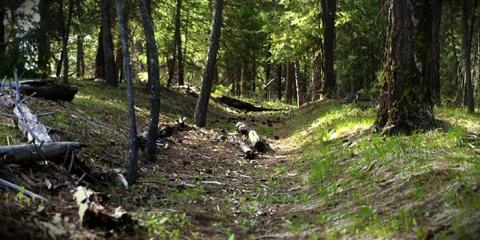‘Dancing on the deck…’
April 30, 2013
“We cannot afford to continue business as usual,” said Kent Connaughton, regional forester for the US Forest Service’s Pacific Northwest Region, comprising 25 million acres of national forests in Oregon and Washington, and the Columbia River Gorge National Scenic Area.
Connaughton keynoted the Oregon Society of Oregon Foresters’ annual meeting in Pendleton, April 24-26. His topic: “The future vision for eastern Oregon forests and forestry given the challenges and changes.”
According to Connaughton, 5 to 6 million acres of national forests in Oregon and Washington are in urgent need of active management to restore forest health and fire resiliency. The current rate of response is inadequate to the problem – meaning that, despite good intent, “we’re just dancing on the deck,” Connaughton said.
Left unsaid was, the deck of what? But I inferred he meant the deck of a sinking ship.
The OSAF confab took place at the Wildhorse Resort, located at the base of the Blue Mountains, where Connaughton said 1.26 million acres could benefit from active management.
The regional forest chief has initiated a strategy for increased action in the Blues, including the Malheur, Ochoco, Wallowa-Whitman and Umatilla national forests. The strategy includes:
- an internal group of experienced Forest Service leaders to lead the effort
- an energetic coordinator to implement it
- a dedicated interdisciplinary scientific team to conduct environmental analyses and explore innovative ways to increase the pace and scale of sustainable, active forest management
Connaughton said he regards the Blue Mountains as a “gateway” to a broader discussion of forest restoration in the Pacific Northwest region.
One key to moving past “business as usual” and the gridlock over forest management is the use of collaboratives, Connaughton said. While he warned that these community-based groups are not a magic bullet, he said they have been helpful in building a common ground for moving forward at a landscape level, which he defined as areas of 10,000 to 15,000 acres. Doing so will require broad public support at the local, state and national levels, he said.
In a recent letter to Gov. John Kitzhaber, Connaughton wrote: “As described in the state’s National Forest Health Restoration Economic Assessment for Oregon, I believe a partnership with the State of Oregon is ripe to advance our collective desire to increase the pace and scale of management. I am hopeful a new business model can generate creative new approaches to funding, increased planning efficiencies, and collaborative alignment needed to achieve this outcome.”
To which I can only add: “Aye, captain.”
For the Forest,
Paul Barnum
Executive Director
Photo: Even the Oregon Trail, located on Emigrant Hill in the Blue Mountains east of Pendleton, has become choked with dense stands of fir and lodgepole pine where once stood widely spaced ponderosa pine amid grassy fields. Early settlers negotiated the highly treacherous seven-mile, 2,000-foot elevation drop into the Umatilla Valley.
